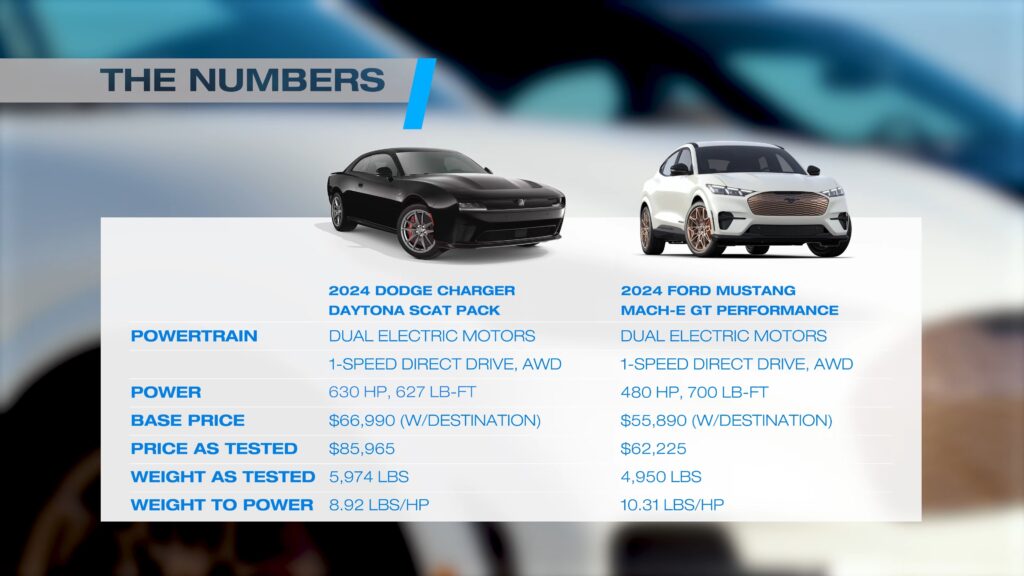- The Mustang Mach-E GT Performance puts out 480 hp and 700 lb-ft while and weighs 4,950 pounds.
- The Charger Daytona Scat Pack delivers 670 hp using Powershot but tips the scales at nearly 6,000 pounds
- A U-drag race evaluates their acceleration, braking, and cornering in one intense head-to-head battle.
The idea of two American hallmarks of the automotive industry going all-electric might have sounded like a bad sci-fi subplot just a few decades ago, but here we are, watching it happen in real time. The Mustang Mach-E GT Performance and the Dodge Charger Daytona are taking their rivalry to the track in a U-drag race to determine which EV carries its weight (literally) better.
var adpushup = window.adpushup = window.adpushup || {que:[]};
adpushup.que.push(function() {
if (adpushup.config.platform !== “DESKTOP”){
adpushup.triggerAd(“0f7e3106-c4d6-4db4-8135-c508879a76f8”);
} else {
adpushup.triggerAd(“82503191-e1d1-435a-874f-9c78a2a54a2f”);
}
});
As a reminder, a U-drag race is exactly what it sounds like. At the end of a quarter-mile conventional drag race, the competitors have to turn around and race back to the start line as fast as they can. Essentially, the test helps us understand acceleration, braking, and handling in one convenient competition.
Read: Stellantis Halts Charger Daytona Production As It Temporarily Cuts 5,400 Jobs And Idles Plants
Our entrants are two of the most controversial American cars this side of a Tesla. First up, the Ford Mustang Mach-E GT Performance, which delivers 480 horsepower (357 kW) and 700 lb-ft (948 Nm) of torque. It weighs in at around 4,950 pounds (2,245 kg), making it over 1,000 pounds (453 kg) lighter than its rival.
In the other corner, there’s the Dodge Charger Daytona, weighing in at a hefty 5,974 pounds (2,709 kg). Sure, it’s heavier – by a lot – but it makes up for it with sheer muscle. When the driver hits the special “Powershot” button, the Charger unleashes 670 horsepower (499 kW) and 630 lb-ft (853 Nm) of torque, turning that mass into serious forward momentum.
Numbers vs. Reality

Specs are nice, but we’re here for results. Off the line, the Mustang jumps ahead, its lighter weight helping it put its power down quicker. But it’s short-lived. The Dodge claws back ground almost immediately and overtakes before the first leg is over.
By the end of the quarter-mile, the Dodge is more than a full car length ahead. In the bend at the end, the Mustang is quicker to make the turn, but not quick enough. The Dodge has a large enough lead that it exits the corner ahead and stretches that lead to the finish line.
Round Two: Dodge Power, Ford Control
var adpushup = window.adpushup = window.adpushup || {que:[]};
adpushup.que.push(function() {
if (adpushup.config.platform !== “DESKTOP”){
adpushup.triggerAd(“bb7964e9-07de-4b06-a83e-ead35079d53c”);
} else {
adpushup.triggerAd(“9b1169d9-7a89-4971-a77f-1397f7588751”);
}
});
Race two goes largely the same way, but with one notable change: the Charger struggles during the braking segment and nearly moves into the Mustang’s lane. The consensus is uniform; the Charger is faster, but much more unruly. It feels like an old-school muscle car, says one host.
Of course, that’s not really a good thing in this case. It’s not the performance that we all love about old-school muscle cars, but rather the unwieldy nature that the new Charger mimics. That sounds like it’s in line with other comments we’ve heard about it. Hopefully, we’ll get our first chance to drive one soon.
For now, the Charger wins on speed, but the Mustang makes a case for balance – just not enough of one to cross the line first.
var adpushup = window.adpushup = window.adpushup || {que:[]};
adpushup.que.push(function() {
if (adpushup.config.platform !== “DESKTOP”){
adpushup.triggerAd(“bb7964e9-07de-4b06-a83e-ead35079d53c”);
} else {
adpushup.triggerAd(“9b1169d9-7a89-4971-a77f-1397f7588751”);
}
});
Credit: Edmunds
#Dodge #Charger #Thinks #Racing #Fords #Fastest #Proved #Hard


